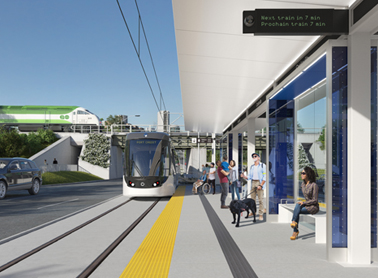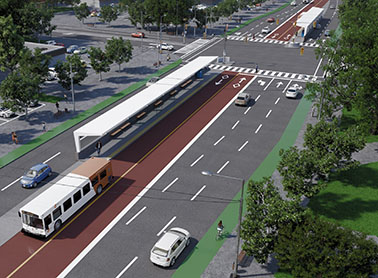What MiWay Five Plus aims to do
Enhance and expand the MiWay service network and infrastructure
- Align MiWay services to support and integrate with the future Hurontario Light Rail Transit (LRT) line and further integrate key transit and express services
- Expand hours of service throughout the week in response to growing ridership demand
- Improve service to major terminals as identified in the MiWay Infrastructure Growth Plan and the City’s planning strategies projects
- Expand the express network to strengthen core and community-oriented services
- Re-align routes to focus on the core network to grow ridership and reduce service duplication
- Address the first-mile and last-mile gaps
Integrate and strengthen connections and infrastructure
- Improve service to major employment areas and key destinations by responding to areas of ridership growth
- Align services with MiWay’s Infrastructure Growth Plan initiatives
- Enhance interregional connections and integrate with neighbouring service providers like Brampton Transit, Toronto Transit Commission (TTC), Oakville Transit, Metrolinx/GO Transit
- Connect to higher-order transit services, such as subway and GO train and bus service
- Integrate and improve connections at major mobility hubs like the future Toronto Pearson Airport Regional Transit Centre
Improve customer experience and service delivery
- Review strategies for optimizing resources and improving the efficiency of service delivery to new and evolving service areas
- Enhance the customer experience for existing riders and earn the trust of new and choice riders by making transit easier through reliable service and improved stops and terminals
- Connect with riders to gather input and feedback on shaping the future of transit services
Public consultations
Hearing from our residents and customers is a crucial part of shaping the development of our plan. We look forward to working with all members of our community to build the foundation for continued transit improvement in Mississauga.
Stay up to date on this project and opportunities for feedback on mivoice.ca.
For more information, email info@miwayfiveplus.com.
Background
The COVID-19 pandemic led to a significant decline in MiWay ridership of 75% on average. Service growth investments planned for 2020 to 2023 were cancelled, suspending the last MiWay 5 Transit Service Plan (2021-2025).
Since the pandemic, we’ve seen a notable shift in ridership and travel patterns. A significant number of key transit and infrastructure projects that were paused during the pandemic are now back on track. Many of these projects are expected to be completed within the next 10 years.
The City is developing the next MiWay Five Plus in response to these recent changes. The initiative is focused on supporting future growth, meeting evolving customer needs and fostering innovation.

